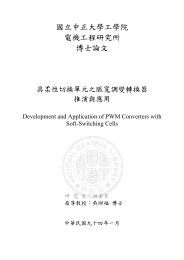Syntax of the Bi Comparative Construction in Mandarin Chinese
Syntax of the Bi Comparative Construction in Mandarin Chinese
Syntax of the Bi Comparative Construction in Mandarin Chinese
You also want an ePaper? Increase the reach of your titles
YUMPU automatically turns print PDFs into web optimized ePapers that Google loves.
<strong>Syntax</strong> <strong>of</strong> <strong>the</strong> <strong>Bi</strong> <strong>Comparative</strong> <strong>Construction</strong> <strong>in</strong> Mandar<strong>in</strong> Ch<strong>in</strong>ese<br />
c. Zhangsan bi Lisi xihuan paobu, Wangwu ye shi/<br />
Zhangsan COM Lisi like jogg<strong>in</strong>g Wangwu too AUX/<br />
bi Zhaoliu ye shi.<br />
COM Zhaoliu too AUX<br />
‘Zhangsan likes jogg<strong>in</strong>g more than Lisi/Zhaoliu, and so does Wangwu.’<br />
When <strong>the</strong> subjects are compared <strong>in</strong> <strong>the</strong>se three sentences, we can only get <strong>the</strong><br />
mean<strong>in</strong>g <strong>of</strong> comparison between Wangwu and Lisi. That it, Wangwu is <strong>the</strong> subject <strong>of</strong><br />
<strong>the</strong> second clause, which support <strong>the</strong> idea that <strong>the</strong> second conjunct toge<strong>the</strong>r with <strong>the</strong><br />
common predicate form a predicate for <strong>the</strong> first subject. All <strong>the</strong>se give more support<br />
to <strong>the</strong> adjunction analysis.<br />
As for <strong>the</strong> semantic reconstruction, it seems that PF deletion is more plausible.<br />
(57) a. Zhangsan zuotian dazi bi Ø Ø xiezi kuai<br />
Zhangsan yesterday type COM write fast<br />
‘Zhangsan typed faster than wrote yesterday.’<br />
b. Zhangsan Ø youyong bi Ø zuotian paobu hai kuai<br />
Zhangsan swim COM yesterday run more fast<br />
‘Zhangsan swims faster than he ran yesterday.’<br />
Besides, Hs<strong>in</strong>g states that we cannot use focus to expla<strong>in</strong> deletion, for shi may<br />
occur <strong>in</strong> <strong>the</strong> F position or moves to <strong>the</strong> C position as (54), yet we cannot tell whe<strong>the</strong>r<br />
it is auxiliaries or <strong>the</strong> word shi that serves as <strong>the</strong> emphatic marker, and <strong>the</strong> positions <strong>of</strong><br />
bi word and <strong>the</strong> operator are not specified yet.<br />
Regard<strong>in</strong>g <strong>the</strong> syntactic structure <strong>of</strong> BCC, Hs<strong>in</strong>g’s research is <strong>in</strong> favor <strong>of</strong> <strong>the</strong><br />
Adjunction analysis, ra<strong>the</strong>r than <strong>the</strong> Coord<strong>in</strong>ation analysis. Relative to <strong>the</strong> syntactic<br />
34<br />
中正大學 e-Thesys (94 學年度)





